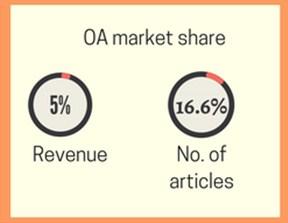
1 minute read
OA Journals
Types of OA Journals
In 2014, English language peer-reviewed journals and non-English language peer-reviewed journals accounted for 28,100 and 6450 respectively [10]. The growth rate has been consistent in the number of journals at 3.5% per year [10]. The number of open access journals has significantly increased in Directory of Open Access Journals (DOAJ), an online directory that houses indexed, open access, and peer-reviewed journals. However, not all journals are peer-reviewed in DOAJ. Scopus had 4,200 OA journals (19.5%) as of January 2016 and Web of Science had 1,234 (9.9%) OA journals as of October 2015. Mega journals, pioneered by PLOS ONE are the most rapidly growing segment of the OA journals. Many journals have tried to implement the same model of these mega journals, keeping the traditional peer-review process [10]. In addition, increasing number of journals in biomedical and life sciences fields are opting for delayed open access, wherein content is made available typically after an embargo period of six to twelve months. As of 2012, 492 journals were delayed access. Interestingly, it was observed that delayed OA journals had twice
Advertisement


as high citation rates as subscription journals [10].

OA JOURNALS
Publishing in OA Journals
Several new technologies are driving OA journal publishing. Key sectors where these technologies can help include, transforming from PDFs to HTMLs, using web hosting service, utilizing services such as DOIs, indexes, and organizing content production in terms of metadata and layout.








